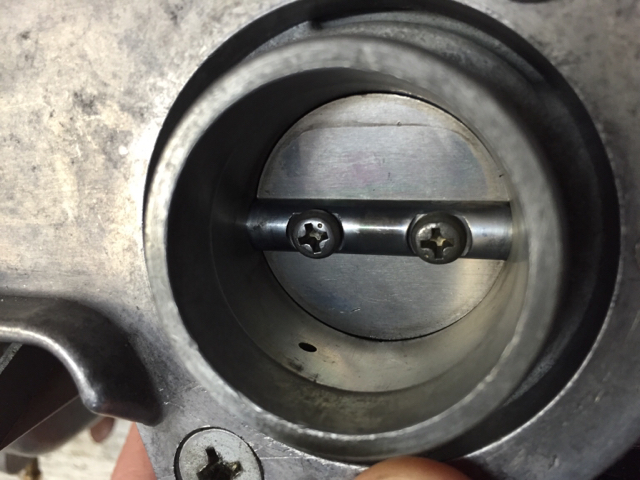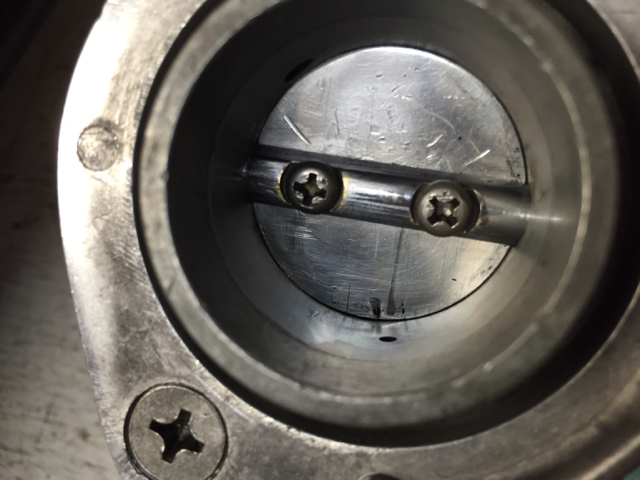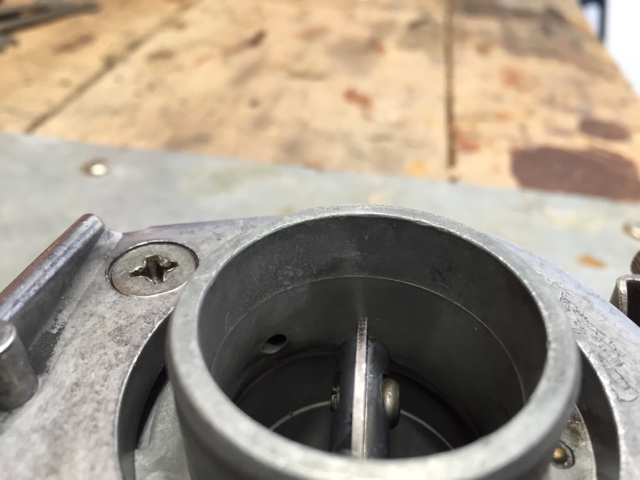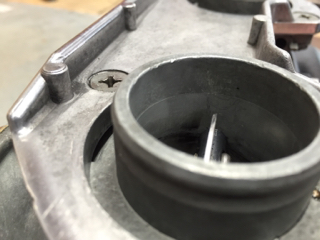We noticed you are blocking ads. DO THE TON only works with community supporters. Most are active members of the site with small businesses. Please consider disabling your ad blocking tool and checking out the businesses that help keep our site up and free.
You are using an out of date browser. It may not display this or other websites correctly.
You should upgrade or use an alternative browser.
You should upgrade or use an alternative browser.
CB360 High Idle / Mess
- Thread starter adventurco
- Start date
adventurco said:Butterflies and throttle operation are normal. Ensured that throttle pull cable was not opening the throttle plates at all when installed (if cable was too short).
Do the butterflies close fully? You'll be amazed at how little they need to be open at idle.
hillsy said:Do the butterflies close fully? You'll be amazed at how little they need to be open at idle.
Here are pics of the plates w/idle speed screw backed out all the way, left and right respectively.


I've always bench synced with a paperclip and then backed it the idle speed screw all the way out before starting. I've always had decent success with this method (until this bike).
crazypj
Split personality, I fake being smart
I thought I had both the throttle plates out?
I remember the right side was bent in two directions but was closing all the way.
I remember I had a hell of a job getting it centred after it was flat (the damage was a LOT worse before repair)
Left side doesn't look like it was ever removed? (Usually, if I polish one side I automatically do the other side to match)
In the pics, the cables are not connected to carb?
I remember the right side was bent in two directions but was closing all the way.
I remember I had a hell of a job getting it centred after it was flat (the damage was a LOT worse before repair)
Left side doesn't look like it was ever removed? (Usually, if I polish one side I automatically do the other side to match)
In the pics, the cables are not connected to carb?
crazypj said:In the pics, the cables are not connected to carb?
Yep, those photos are on the bench, no cables connected and idle speed screw backed out all the way.
Throttle plates can sometimes be a bit tricky to get just right. They should "look" like they have an air tight seal to the bore when fully closed. You can remove them and observe the available rotation of the shafts to be certain that the throttle plates themselves are in fact the component keeping the throttles from closing any further. Since you are having issues it is a good thing to check that the shafts can rotate farther than needed to be sure that there is in fact not some other issue. Assemble the throttle plates very loose and allow them to seat perfectly within the bores so they are as closed as possible before tightening the screws that clamp them in place. Might take a little fussing. Most throttle shafts are brass, and quite fragile and very easy to accidentally damage. The chrome plating will fool you into thinking they are stronger than they are, so a super careful examination is recommended. Looks like there has been a bit of harsh treatment handed out to the plates at some point judging by your pics, so a close look is important. The dents and scratches themselves are not a problem, but may indicate damage that is. They need to be dead flat or you will have difficulty. You can rub them lightly on a piece of glass and some very fine (#1000 grit or more) wet sandpaper to see any deformation. You will also see that the plates have a bevel cut into the edges that should fit very precisely in the bore when the throttle is completely closed. If this is damaged in any way, you will have trouble. It won't be light tight, but damn near. If it isn't there is trouble somewhere.
crazypj
Split personality, I fake being smart
There is a stop screw to prevent shafts over rotating in 'open' position (and acting as a 'closed' throttle)
I know it is set to within a few thousandths of an inch of 'dead centre' when throttle is fully open. For fully closed position, the linkage has 'over travel' capabilities.
It is a PITA to dismantle everything in linkage but the plate is the only thing stopping shaft rotating.
The only real alternative check is to find a new/undamaged throttle plate and swap it out for the damaged/straightened one. I checked the edges as best I could, they were damaged so I think I radiused them which gives impression plates are further open than they really are (wasn't possible to re-machine the angle on plate - it would become too small for opening at an approx 27 deg angle)
If you remove the plate again, you will have to carefully file down the screw thread as it has been compressed to prevent backing out. You then need to source new screws and remember to crush the ends.
I modified a set of lineman's pliers to get inside carb bore you can see 'teeth marks' on screw heads, (another PITA grinding project) I guess I didn't remove second throttle plate as there are no obvious marks on screw heads
I know it is set to within a few thousandths of an inch of 'dead centre' when throttle is fully open. For fully closed position, the linkage has 'over travel' capabilities.
It is a PITA to dismantle everything in linkage but the plate is the only thing stopping shaft rotating.
The only real alternative check is to find a new/undamaged throttle plate and swap it out for the damaged/straightened one. I checked the edges as best I could, they were damaged so I think I radiused them which gives impression plates are further open than they really are (wasn't possible to re-machine the angle on plate - it would become too small for opening at an approx 27 deg angle)
If you remove the plate again, you will have to carefully file down the screw thread as it has been compressed to prevent backing out. You then need to source new screws and remember to crush the ends.
I modified a set of lineman's pliers to get inside carb bore you can see 'teeth marks' on screw heads, (another PITA grinding project) I guess I didn't remove second throttle plate as there are no obvious marks on screw heads
Wow, I had no idea fitting carb plates was such an exact science. I've never had the need arise to even have to remove them. Lots of great info in the last few posts.
Still haven't made it back from Texas, but should be back around the bike this weekend.
First step will be to rule out throttle plates as an issue, then cables, then sync.
Still haven't made it back from Texas, but should be back around the bike this weekend.
First step will be to rule out throttle plates as an issue, then cables, then sync.
crazypj
Split personality, I fake being smart
You don't need to remove throttle plates to check angle on the edge, just open throttle and take a look. I know the repaired one has pretty rounded off edges from being fitted 'backwards' then pried open or something which bent it 'Z' shaped.
I flatted it out, polished it a bit to remove worst of gouges then fitted it correct way around.
The more you learn about mechanical/electrical/fuel side of engines, etc, the more you'll wonder how they ever got invented (plus how they ever stay in one piece - at least most of the time ;D )
I flatted it out, polished it a bit to remove worst of gouges then fitted it correct way around.
The more you learn about mechanical/electrical/fuel side of engines, etc, the more you'll wonder how they ever got invented (plus how they ever stay in one piece - at least most of the time ;D )
crazypj said:You don't need to remove throttle plates to check angle on the edge, just open throttle and take a look. I know the repaired one has pretty rounded off edges from being fitted 'backwards' then pried open or something which bent it 'Z' shaped.
I flatted it out, polished it a bit to remove worst of gouges then fitted it correct way around.
The more you learn about mechanical/electrical/fuel side of engines, etc, the more you'll wonder how they ever got invented (plus how they ever stay in one piece - at least most of the time ;D )
here here! Most of the time, throttle plates aren't an issue simply because most of the time people don't disturb them. Sometimes really abused ones seem to be fine, but it depends heavily on exactly where the damage is. They have to fit close so the high speed airstream directly over the pilot system is what it needs to be. If that part is intact, and some other part simply passes a bunch more air, it is easy to see where there will not be sufficient airspeed over the pilot because of the leakage elsewhere. You might be able too compensate by going with much larger pilot fuel jet, but as soon as you crack the plates open, you would have another problem to deal with because you will have "normal" air but way too much fuel. On the other hand, if the perimeter is fine and the area over the pilot is wide, you will never get enough airspeed over it to work rightly. It is a tiny thing, but from what you say, your engine is fine except for idle - also known as nearly closed throttle where very tiny details are all that count.
crazypj
Split personality, I fake being smart
jpmobius said:here here! Most of the time, throttle plates aren't an issue simply because most of the time people don't disturb them. Sometimes really abused ones seem to be fine, but it depends heavily on exactly where the damage is. They have to fit close so the high speed airstream directly over the pilot system is what it needs to be. If that part is intact, and some other part simply passes a bunch more air, it is easy to see where there will not be sufficient airspeed over the pilot because of the leakage elsewhere. You might be able too compensate by going with much larger pilot fuel jet, but as soon as you crack the plates open, you would have another problem to deal with because you will have "normal" air but way too much fuel. On the other hand, if the perimeter is fine and the area over the pilot is wide, you will never get enough airspeed over it to work rightly. It is a tiny thing, but from what you say, your engine is fine except for idle - also known as nearly closed throttle where very tiny details are all that count.
The 360 has pretty strange carbs.
I'm guessing your pretty familiar with automotive carbs so you'll know about various bypass circuits?
The Kei-Hin carbs on 360 have 3 bypass holes fed directly from primary main jet in addition to the main discharge controlled by fuel screw. and pilot jet By the time throttle plate moves from closed (around 30 degree angle) to about 32~33 degrees (less than 1/64"?) all the bypass are being used. The primary main jet is also coming into use through it's discharge tube/nozzle at around 3/32" under throttle plate and is the main fuel-fuel air delivery until around 4~4,500rpm when secondary main starts working as slide starts to lift - about 3/8" under throttle plate (it's why these carbs are such 'fun') I've lost count of the throttle plates not set or centered properly or the throttle stop screw set so far over center carb goes full throttle then back's off to about 3/4 when grip is turned all the way. Anyway, it may be worth trying to set the throttle plates deliberately off center slightly to close all the bypass drillings
Upon close inspection of the plates, I see a very slight angle on the edges of each plate. The angle is sloping in towards the interior of the carburetor (the slightly larger radius is facing engine side, slightly smaller radius facing into the carburetor. The repaired plate has slightly less thickness than the untouched one, but the bevel is facing the same direction




Put the carbs back in without the throttle cables installed, so we can rule that out. Managed to get the carbs synced at about 12 in/Hg, and with the A/F mixture screws backed out at 2.5 turns, the idle is still too high but seems to have smoothed out significantly.
After syncing, I noticed a trace of whitish smoke coming out of the breather cover filter. Not good. Could this be exhaust smoke exiting through the breather due to incorrect valve timing? I was sure to set the tappets to spec and held the crank at overlap when adjusting the tappets.
After syncing, I noticed a trace of whitish smoke coming out of the breather cover filter. Not good. Could this be exhaust smoke exiting through the breather due to incorrect valve timing? I was sure to set the tappets to spec and held the crank at overlap when adjusting the tappets.
crazypj
Split personality, I fake being smart
Nope, not exhaust. It's more likely water vapor 'boiling' out of the oil. It's 'good' -try sticking your hand in the vapor and sniffing it, shouldn't smell too much of oil, you may even get water condensing on your hand?
It's the reason why engines need to be run until over 212f and short trips are so bad as 'blowby' condensation gets into oil/crankcase (all internal combustion engines do it)
Fuel screws 2.5 turns out is a lot more than normal but still in the 'OK' parameter for pilot jet, you may need to make further adjustments as you get some miles on it
From the feedback I've been getting, you will need to run bike for about 200 miles (2 tanks gas) before everything settles down properly and you can make correct adjustments.
Although it shouldn't be necessary, the throttle plates will bed in with use and become more 'usable'
The motor should be running a LOT 'cleaner' after couple of tanks gas.
I thought plates were correctly installed but it's always good to check
I've only ever had one worse set of carbs, they were the only ones I couldn't fix and owner had to eBay for 'new' ones ( around 20 hrs on them so far )
)
It's the reason why engines need to be run until over 212f and short trips are so bad as 'blowby' condensation gets into oil/crankcase (all internal combustion engines do it)
Fuel screws 2.5 turns out is a lot more than normal but still in the 'OK' parameter for pilot jet, you may need to make further adjustments as you get some miles on it
From the feedback I've been getting, you will need to run bike for about 200 miles (2 tanks gas) before everything settles down properly and you can make correct adjustments.
Although it shouldn't be necessary, the throttle plates will bed in with use and become more 'usable'
The motor should be running a LOT 'cleaner' after couple of tanks gas.
I thought plates were correctly installed but it's always good to check
I've only ever had one worse set of carbs, they were the only ones I couldn't fix and owner had to eBay for 'new' ones ( around 20 hrs on them so far
crazypj said:Nope, not exhaust. It's more likely water vapor 'boiling' out of the oil. It's 'good' -try sticking your hand in the vapor and sniffing it, shouldn't smell too much of oil, you may even get water condensing on your hand?
It's the reason why engines need to be run until over 212f and short trips are so bad as 'blowby' condensation gets into oil/crankcase (all internal combustion engines do it)
Interesting. I hadn't noticed it before on any of my other bikes, maybe it has to do with the oil I'm running. Glad to know it's 'normal'.
Even with the 2.5 turns out, she's still idling a bit faster than she should, 3 turns out is the threshold for pilot jet if i remember correctly?
Should I be worried about riding with a higher-than-normal idle speed, or just put some miles on it and see if it doesn't 'iron itself out' like you mentioned?
crazypj said:I've only ever had one worse set of carbs, they were the only ones I couldn't fix and owner had to eBay for 'new' ones ( around 20 hrs on them so far)
Hah, I had been thinking about doing the same before I sent them out. Nothing but problems with these Keihins. :
crazypj
Split personality, I fake being smart
The only time the high idle can be an issue is if your changing down for a junction or turn and appear to be going too fast.
Pulling clutch can make bike a little unstable in some situations but probably 99.999% of time it's just an irritation
If you take it easy first hundred miles or so you should be fine. (just heat cycling without riding will also help)
Make sure idle adjust cable isn't actually touching stop but only give a few thou clearance or throttle plate could get damaged from 'snapping shut' rather than just bedding into correct shape/position
Have you re-fitted breather tube to connection on head? Unless you've had older bikes or K&N filters regularly, the breather always goes int air-box for gas recirculation s you wouldn't notice water vapor
Pulling clutch can make bike a little unstable in some situations but probably 99.999% of time it's just an irritation
If you take it easy first hundred miles or so you should be fine. (just heat cycling without riding will also help)
Make sure idle adjust cable isn't actually touching stop but only give a few thou clearance or throttle plate could get damaged from 'snapping shut' rather than just bedding into correct shape/position
Have you re-fitted breather tube to connection on head? Unless you've had older bikes or K&N filters regularly, the breather always goes int air-box for gas recirculation s you wouldn't notice water vapor
Finally had the time to put my head down and get to work on this thing. I went through and readjusted the cam chain, valves and timing since I haven't touched any of it since the first ride. Fired her up, and the idle seemed normal. Synced the carbs up and she seemed to be running nice. Got in a quick ride and besides a bit of top end chatter at high RPMs, everything seemed to be going well.
So I can't be sure what was the real cause of my problems, but my guess is something with the valve timing was causing the high idle condition, along with the carbs being out of sync. For now, seems like everything is pretty much ironed out. Thanks for all the input gents.
So I can't be sure what was the real cause of my problems, but my guess is something with the valve timing was causing the high idle condition, along with the carbs being out of sync. For now, seems like everything is pretty much ironed out. Thanks for all the input gents.




